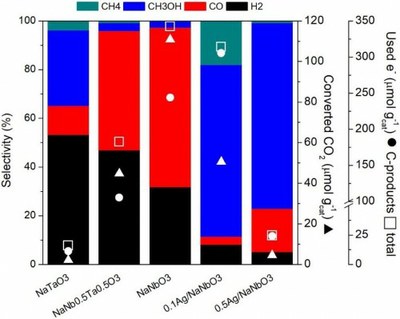Do you want to keep up to date? Subscribe to our newsletter. 1mail every 2months! |
 |

Chemical products produced in the chemical reaction depending on the catalyst used.
Cerdanyola del Vallès, 24th November 2021 The direct conversion of solar energy into chemical energy (that is, fuels) using widely abundant and recyclable raw materials (carbon dioxide, water, oxygen and nitrogen) is destined to become one of the pillars that sustain the transition of the current linear economy to a circular economy. One of the technologies in this frame is artificial photosynthesis, which employs catalysts capable of using light as energy source to convert carbon dioxide and water into useful products for chemistry and energy. Since there are different possible products of this conversion, each with a different utility, controlling the selectivity of the process towards one or another is key to the implementation of this technology.
In collaboration with the ALBA Synchrotron and the National University of San Martín in Argentina, researchers from the Photoactivated Processes Unit of IMDEA Energy have published a study on the control of the final products of artificial photosynthesis using as catalysts perovskite-type oxides with silver nanoparticles on their surface. Using several physico-chemical techniques, this work sheds light onto the molecular mechanisms that drive the selectivity changes observed when using different versions of these catalysts. The obtained products range from carbon monoxide, which in combination with hydrogen can be used for subsequent chemical syntheses, to methanol, directly usable, for example, in fuel cells.
References:
- Fresno, F., Galdón, S., Barawi, M., Alfonso-González, E., Escudero, C., Pérez-Dieste, V., Huck-Iriart, C., de la Peña O’Shea, V.A., Selectivity in UV photocatalytic CO2 conversion over bare and silver-decorated niobium-tantalum perovskites. Catalysis Today 2021, 361, 85; https://doi.org/10.1016/j.cattod.2020.01.013
With the collaboration of Fundación Española para la Ciencia y la Tecnología. The ALBA Synchrotron is part of the of the Unidades de Cultura Científica y de la Innovación (UCC+i) of the FECYT and has received support through the FCT-20-15798 project.





